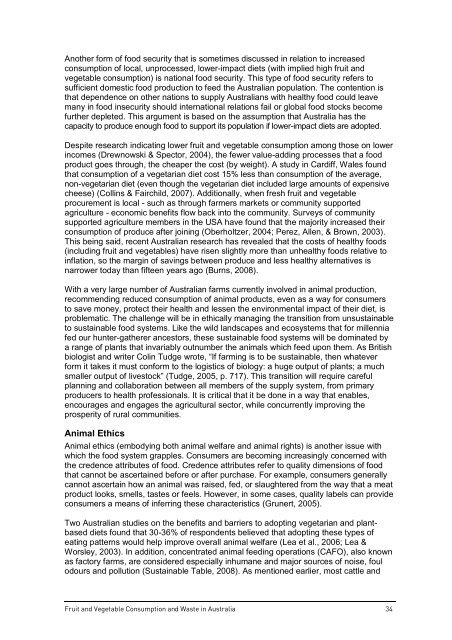Fruit and vegetable consumption and waste in Australia - VicHealth
Fruit and vegetable consumption and waste in Australia - VicHealth
Fruit and vegetable consumption and waste in Australia - VicHealth
You also want an ePaper? Increase the reach of your titles
YUMPU automatically turns print PDFs into web optimized ePapers that Google loves.
Another form of food security that is sometimes discussed <strong>in</strong> relation to <strong>in</strong>creased<br />
<strong>consumption</strong> of local, unprocessed, lower-impact diets (with implied high fruit <strong>and</strong><br />
<strong>vegetable</strong> <strong>consumption</strong>) is national food security. This type of food security refers to<br />
sufficient domestic food production to feed the <strong>Australia</strong>n population. The contention is<br />
that dependence on other nations to supply <strong>Australia</strong>ns with healthy food could leave<br />
many <strong>in</strong> food <strong>in</strong>security should <strong>in</strong>ternational relations fail or global food stocks become<br />
further depleted. This argument is based on the assumption that <strong>Australia</strong> has the<br />
capacity to produce enough food to support its population if lower-impact diets are adopted.<br />
Despite research <strong>in</strong>dicat<strong>in</strong>g lower fruit <strong>and</strong> <strong>vegetable</strong> <strong>consumption</strong> among those on lower<br />
<strong>in</strong>comes (Drewnowski & Spector, 2004), the fewer value-add<strong>in</strong>g processes that a food<br />
product goes through, the cheaper the cost (by weight). A study <strong>in</strong> Cardiff, Wales found<br />
that <strong>consumption</strong> of a vegetarian diet cost 15% less than <strong>consumption</strong> of the average,<br />
non-vegetarian diet (even though the vegetarian diet <strong>in</strong>cluded large amounts of expensive<br />
cheese) (Coll<strong>in</strong>s & Fairchild, 2007). Additionally, when fresh fruit <strong>and</strong> <strong>vegetable</strong><br />
procurement is local - such as through farmers markets or community supported<br />
agriculture - economic benefits flow back <strong>in</strong>to the community. Surveys of community<br />
supported agriculture members <strong>in</strong> the USA have found that the majority <strong>in</strong>creased their<br />
<strong>consumption</strong> of produce after jo<strong>in</strong><strong>in</strong>g (Oberholtzer, 2004; Perez, Allen, & Brown, 2003).<br />
This be<strong>in</strong>g said, recent <strong>Australia</strong>n research has revealed that the costs of healthy foods<br />
(<strong>in</strong>clud<strong>in</strong>g fruit <strong>and</strong> <strong>vegetable</strong>s) have risen slightly more than unhealthy foods relative to<br />
<strong>in</strong>flation, so the marg<strong>in</strong> of sav<strong>in</strong>gs between produce <strong>and</strong> less healthy alternatives is<br />
narrower today than fifteen years ago (Burns, 2008).<br />
With a very large number of <strong>Australia</strong>n farms currently <strong>in</strong>volved <strong>in</strong> animal production,<br />
recommend<strong>in</strong>g reduced <strong>consumption</strong> of animal products, even as a way for consumers<br />
to save money, protect their health <strong>and</strong> lessen the environmental impact of their diet, is<br />
problematic. The challenge will be <strong>in</strong> ethically manag<strong>in</strong>g the transition from unsusta<strong>in</strong>able<br />
to susta<strong>in</strong>able food systems. Like the wild l<strong>and</strong>scapes <strong>and</strong> ecosystems that for millennia<br />
fed our hunter-gatherer ancestors, these susta<strong>in</strong>able food systems will be dom<strong>in</strong>ated by<br />
a range of plants that <strong>in</strong>variably outnumber the animals which feed upon them. As British<br />
biologist <strong>and</strong> writer Col<strong>in</strong> Tudge wrote, “If farm<strong>in</strong>g is to be susta<strong>in</strong>able, then whatever<br />
form it takes it must conform to the logistics of biology: a huge output of plants; a much<br />
smaller output of livestock” (Tudge, 2005, p. 717). This transition will require careful<br />
plann<strong>in</strong>g <strong>and</strong> collaboration between all members of the supply system, from primary<br />
producers to health professionals. It is critical that it be done <strong>in</strong> a way that enables,<br />
encourages <strong>and</strong> engages the agricultural sector, while concurrently improv<strong>in</strong>g the<br />
prosperity of rural communities.<br />
Animal Ethics<br />
Animal ethics (embody<strong>in</strong>g both animal welfare <strong>and</strong> animal rights) is another issue with<br />
which the food system grapples. Consumers are becom<strong>in</strong>g <strong>in</strong>creas<strong>in</strong>gly concerned with<br />
the credence attributes of food. Credence attributes refer to quality dimensions of food<br />
that cannot be ascerta<strong>in</strong>ed before or after purchase. For example, consumers generally<br />
cannot ascerta<strong>in</strong> how an animal was raised, fed, or slaughtered from the way that a meat<br />
product looks, smells, tastes or feels. However, <strong>in</strong> some cases, quality labels can provide<br />
consumers a means of <strong>in</strong>ferr<strong>in</strong>g these characteristics (Grunert, 2005).<br />
Two <strong>Australia</strong>n studies on the benefits <strong>and</strong> barriers to adopt<strong>in</strong>g vegetarian <strong>and</strong> plantbased<br />
diets found that 30-36% of respondents believed that adopt<strong>in</strong>g these types of<br />
eat<strong>in</strong>g patterns would help improve overall animal welfare (Lea et al., 2006; Lea &<br />
Worsley, 2003). In addition, concentrated animal feed<strong>in</strong>g operations (CAFO), also known<br />
as factory farms, are considered especially <strong>in</strong>humane <strong>and</strong> major sources of noise, foul<br />
odours <strong>and</strong> pollution (Susta<strong>in</strong>able Table, 2008). As mentioned earlier, most cattle <strong>and</strong><br />
<strong>Fruit</strong> <strong>and</strong> Vegetable Consumption <strong>and</strong> Waste <strong>in</strong> <strong>Australia</strong> 34


